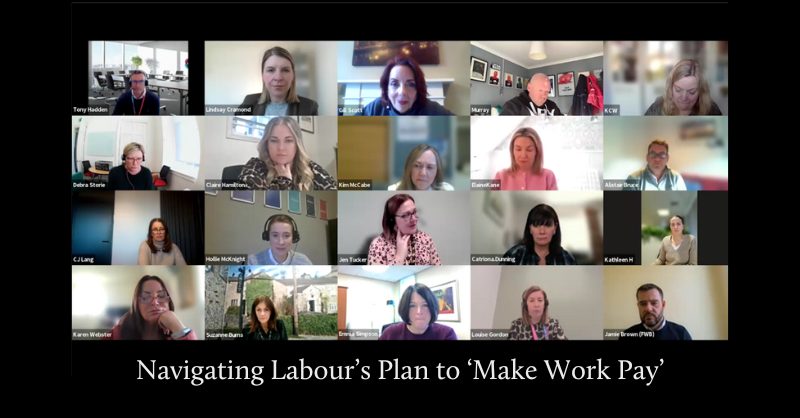Contact the team at FWB to discuss your individual or company requirements, or to discover more about our specialist services.
Book Launch & Lunch with Dr Susan Hetrick
19 September 2023
- SHRLG
- Thought Leadership
Last month at Brodies, we launched Dr Susan Hetrick's latest book, “Toxic Organisational Cultures and Leadership”. Our event began with a networking lunch attended by HR professionals and concluded with an insightful interview and Q&A, guided by our own Alix Meekison. In this interview, we explore the depths of workplace dynamics, uncovering the origins of toxic cultures and their profound influence on organisations. Today, we're excited to share with you the key takeaways from this event and our enriching conversations with Susan:
Toxic Organisational Cultures and Leadership
Dr Susan Hetrick has been exploring organisational dynamics, in particular the dark side of corporate culture, toxic cultures, and leadership. Hetrick's new book, 'Toxic Organisational Cultures and Leadership' sheds light on this intricate issue, unveiling the drivers that contribute to the emergence and sustenance of these detrimental environments. The book explores the often-overlooked aspects of a toxic culture, prompting readers to question the influences of leadership, behaviours, and societal factors.
Defining Toxic Culture
A toxic culture is an organisational environment that permits harmful behaviours to thrive, causing lasting damage. When Hetrick first embarked on her journey to explore what she calls 'the dark side of organisations', she noticed an absence of discussions about the negative aspects of cultures. The term “toxic” itself, stemming from ancient Greek origins -“Toxicon” meaning poison -resonates deeply, illustrating the harmful elements that can infiltrate organisational structures.
Our audience and Hetrick debated about whether toxic culture and leadership is ever positive; however, the statistics paint a grim picture. It is estimated that one in two people leave their jobs because of issues with their boss. Calculations suggest that toxic cultures cost a staggering $225 billion USD in sickness, absence, health care and other relevant factors.
Inspiration Behind the Book
When questioned about the inspiration behind her latest book, Hetrick reveals that her own life experiences served as the driving force. Her own career journey, coupled with the aspiration to make a meaningful difference, has fuelled her exploration into this subject area. Hetrick's dedication to bringing about positive and meaningful change, particularly within the field of HR, has led her to delve into a topic which has long been overlooked. She recounts a pivotal moment when reading a book on the evils of transformational leadership, a moment that struck a chord with her and influenced her examine the rising prevalence of toxic organisations. Frequent reports of corporate mismanagement compelled her to seek the answers as to why these issues are becoming so widespread.
The Role of Leadership
Central to Hetrick’s analysis is the role of leadership in shaping organisational culture. She explained that organisational culture and leadership are two sides of the same coin. Leaders serve as role models whose actions reverberate throughout an organisation. Their influence impacts individuals at all levels of organisational hierarchy -from junior employees to supervisors -the behaviour of leaders can shape the workplace environment.
When asked of any leaders, in her view and experience, that have shown effective leadership, Hetrick named individuals who listen, make have demonstrated strong listening skills, thoughtful decision-making, and a genuine commitment to their teams.
The Foundations of Toxic Culture
As Hetrick discusses the origins of toxic cultures, she expresses that they don't just appear overnight. Instead, they evolve through several stages. Normalisation of deviance, coined after the Challenger Space Shuttle disaster in 1986 highlights how performance pressures and subtle shifts from established norms can gradually normalise deviant behaviours. Cognitive dissonance also plays a role, as individuals attempt to rationalise actions or beliefs that differ to their personal values.
Hetrick and the audience shared real-life examples -from the Volkswagen emission scandal to unethical practices at RBS -and how even well-established organisations can fall prey to toxic cultures.
The Toxic Triangle
Hetrick's latest book introduces the “Toxic Triangle” as a framework that reveals the dimensions which combine to make a workplace culture toxic. The triangle comprises of “colluders”, individuals who actively contribute to or support toxic behaviours; “conformers”, those who follow along without actively participating; and the “conducive environment”, the organisational climate that fosters such behaviours. Pressures on performance management and external reverence also contribute the development of this environment.
Addressing Toxic Cultures
So, what can be done to address toxic cultures? Hetrick’s book outlines pathways to transformation. Hetrick's recommendations examine the responsibility of leaders to cultivate an environment that values accountability and ethical behaviour, the role of Boards, and the importance of surveys and practical tools to measure employee satisfaction and engagement.
Millennials, known for their preference to work for values-driven organisations, play a role in reshaping cultures. With a generational shift, organisations are compelled to adapt to changing expectations and work ethics.
Conclusion
Susan Hetrick's latest book concludes with a call to action for organisations, senior leaders, HR professionals and Boards to act and implement strategies that will support the identification and measurement of toxic cultures in the workplace. Toxic culture must be recognised, understood, and transformed. By exploring its origins, impacts, and potential solutions, Hetrick offers a roadmap to fostering healthier, more respectful, and more productive workplaces.





